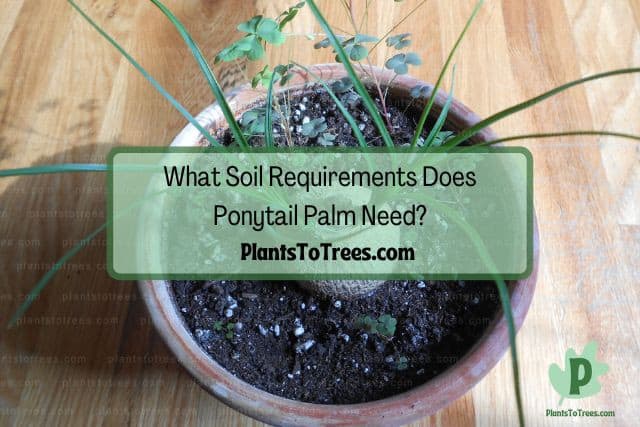Ponytail palm isn’t a palm at all and is actually a succulent. And as many of you are aware of, succulents are generally easy-going plants that require little care. Even though they are low maintenance, they do bring a lot of personality to a room.

The ponytail palm care guide will break down the growing requirements that this plant requires. That includes how cold hardy the plant is, what type of lighting it needs, how much water you should give it, and what diseases you can expect when growing the plant.
Ponytail palms don’t have too many problems, but since they are a succulent, they are susceptible to overwatering. This means that you will need to let the soil dry out a bit between waterings. Thankfully, this is really the only serious problem you need to be concerned with.
Ponytail palms are also tolerant of various growing conditions as long as they aren’t overwatered. This makes the ponytail palm a great option for those who are new to growing plants or anyone that wants a no-hassle houseplant.
One of the few drawbacks of the ponytail palm is that it isn’t cold hardy, which means it cannot grow outdoors in most areas. Thankfully, the ponytail palm works well as an indoor plant.
Other Names Of Ponytail Palm
While ponytail palm is the name that this plant is most known by, it isn’t the only one. Let’s look at the other names that this plant sometimes goes by.
The ponytail palm is also called the elephant foot tree or the bottle palm tree. Despite the different names, the ponytail palm is not a palm at all and is actually a succulent. Taking a look at the ponytail palm you can quickly see why it’s confusing, since it has a single trunk with leaves on top.
Frost Tolerance And USDA Hardiness Zones Of Ponytail Palm
Most people grow plants indoors because they cannot grow the plant outside in their climate. The truth is, some of the most common houseplants are native to tropical regions and just cannot survive the frost and cold that most of the United States experiences.
The ponytail palm is not frost tolerant nor is it cold hardy. It can, however, grow outdoors in USDA Plant Hardiness Zones 9 to 12. Even though this plant cannot handle cold temps for too long, mature ponytail palms can tolerate temps as low as 20 degrees for short periods of time.
If you live in an area outside these hardiness zones, you can still move the ponytail palm outside in periods of warm weather. Just make sure the plant is protected from direct sunlight and extreme weather. Additionally, don’t forget to bring the succulent back inside before the weather starts dropping.
How Many Hours Of Sunlight Does Ponytail Palm Need?

The amount of sunlight the ponytail palm needs is another vital aspect of growing plants indoors that you shouldn’t skip over. After all, not giving the plant enough sun can cause stunted growth, while giving it too much can also affect how healthy the plant is.
The ponytail palm needs 8 hours of sunlight every day. The light needs to be indirect and bright. This plant can tolerate conditions with lower light, but it’s best to provide it with the optimal lighting conditions for healthy and strong growth.
Ponytail Palm Needs Direct Or Indirect Sunlight?
Direct or indirect sunlight are two greatly different lighting options that you probably know about, especially if you have experience growing plants. You will need to learn which type of lighting the ponytail palm needs before growing it.
Bright, indirect sunlight is the ideal lighting conditions for the ponytail palm. This plant needs an abundance of sun, but doesn’t do well in direct sunlight. Direct light can severely damage the ponytail palm’s foliage.
Is Ponytail Palm An Indoor Plant, Outdoor Plant Or Both?

Ponytail palms, like most other plants, can be grown either indoors, outdoors, or both. However, this will depend on your climate and hardiness zone. Let’s look at the growing requirements for the ponytail palm.
Ponytail palms are typically grown indoors as a houseplant, though it can also grow outside if in USDA Hardiness Zones 9 to 12. If you live outside of these zones, you can still move the plant outside during periods of warm weather. Remember to bring the plant indoors before it gets too cold.
What Are The Indoor Lighting Requirements For Ponytail Palms?
When growing the plant indoors, it can be a little more difficult to provide the ponytail palm with the correct lighting requirements. This is because you will need to find an indoor location where the plant can get the same type of light that it would get when growing outside in its native habitat.
When grown indoors, the ponytail palm needs bright light but never light that is direct. Direct sunlight will cause the plant’s foliage to burn. Not only does this have a negative effect on the overall appearance of the plant, but it can also put undo stress on the ponytail palm.
What Are The Outdoor Lighting Requirements For Ponytail Palms?
Just because the plant is grown outdoors doesn’t mean its lighting requirements will be any different than if you grew it inside.
Bright, indirect light is what works best for this plant both indoors and out. An outdoor location where the lighting is dappled will protect the ponytail palm from direct sun while still giving the plant the light it needs.
What Soil Requirements Does Ponytail Palm Need?

The type of soil you grow your ponytail palm in will have a direct effect on the overall health and well-being of the plant. That is why it is important to make sure you use the correct soil for this succulent.
Sandy soil that allows the water to drain quickly is the best soil for ponytail palms. Succulent and cacti potting mix works well for this plant, but you can also make your own. Mix equal parts potting soil, sand, and perlite.
The most important thing to remember is that the soil cannot be compact as this type of soil doesn’t allow for the water to drain properly. And when the soil can’t drain, it sits in the soil, creating a soggy mess that can be detrimental to the ponytail palm’s health and wellness.
How Much Water Does Ponytail Palm Need?
Having a good general idea of how often a ponytail palm will need watered can go a long way to preventing overwatering.
Ponytail palms don’t require much watering because this plant is a succulent. In most cases, you will only need to water the plant once every 2 weeks, but this can change depending on environmental factors. Wait until the soil is dry before watering the plant.
Some gardeners prefer to use filtered, distilled, or spring water, while others use tap. This is really just a personal preference that you, as an indoor gardener, will have to decide for yourself.
If you do use tap water, it is recommended to let the water sit for about 24 hours before using it to water the ponytail palm. This will give the chlorine in the tap water a chance to dissipate beforehand.
Is My Ponytail Palm Overwatered, What Are The Symptoms?

Overwatering is a common problem that many gardeners have. While this issue is a serious one, it is easily preventable by allowing the soil to dry out a little between waterings.
Overwatering your ponytail palm will cause the entire plant to go limp, while also discoloring the leaves. As the overwatering progresses, water-filled blisters will appear on the leaves and stem, leaves may drop from the plant, and root rot will occur.
Unfortunately, once root rot occurs, the chances of saving the ponytail palm significantly dwindle. If you would still like to try to save the plant, you will need to carefully glide the entire plant out of the container and then use your fingers to remove all the soil.
Examine the roots and snip off any that are brown, dead, rotted, or damaged. Then simply repot the plant in a new container and fresh soil.
Is My Ponytail Palm Underwatered, What Are The Symptoms?
Underwatering a houseplant isn’t nearly as detrimental as overwatering it, but that doesn’t mean you shouldn’t try to prevent it, since an underwatered ponytail palm is a stressed and unhealthy plant.
Ponytail palms that have been underwatered will start to droop and wilt. The leaves may also hang lower than normal, and they can become dry and crispy. Another common sign of an underwatered ponytail palm is that the soil will be extremely dry and pull away from the container.
How Much Fertilizer Does Ponytail Palm Need? What Kind?

Fertilizers are an important part of growing any plants, even the ones living in your home. Adding fertilizer to houseplants helps to promote strong and healthy growth, while giving the plant vital nutrients that it needs to thrive for years to come.
Fertilize ponytail palms when new growth starts to emerge in the spring. An all-purpose liquid fertilizer diluted to ½ its strength works best for this plant. Apply the fertilizer once or twice a month during the plant’s active growing season, which is from spring to fall.
Ponytail Palm Diseases To Be Aware Of
Ponytail palm is a wonderful plant for beginners to grow because it doesn’t deal with too many diseases. Even though it isn’t susceptible to a lot of diseases, you should still familiarize yourself with the ones that can attack this plant.
Ponytail palms are susceptible to common sap-sucking insects, such as spider mites, scales, and mealybugs. But they don’t have many problems with diseases. On rare occasions, they can develop bacterial leaf streak, stem rot, or leaf spots.
Insecticidal soap works well to safely treat sap-sucking insects, while prevention is the best defense against fungal disease. Most fungal diseases are caused by poor water management, incorrect watering methods, and bad soil drainage.
Are There Different Types Of Ponytail Palm?

Most houseplants come in different types and varieties, and the ponytail palm is no exception. This plant is available in various cultivars. While these cultivars share the same growing requirements, they do differ in appearance.
There are several types of ponytail palms but the most common variety, however, is Beaucarnea recurvata, which is named for its recurving and long foliage. The Beaucarnea stricta is another common variety that has stiff leaves, while the leaves of the Beaucarnea gracilis are thinner.
How To Propagate Ponytail Palm
One of the many benefits to growing houseplants is that most of them can be fairly easy to propagate, which means you can increase your plants without shelling out more money.
Ponytail palms actually propagate themselves by creating side shoots. You can easily divide these shoots during the spring to increase the amount of plants you are growing.
Carefully remove the dirt from around the shoot you want to propagate to expose its base. Use a pair of clean and sharp pruning shears to cut the shoot from the parent plant.
The best shoots are the ones that are about 4 inches tall since they are just starting to create their own root system.
Plant the shoot in the same type of soil that the parent palm is growing in. Cover the entire shoot with plastic wrap, lightly securing it close around the pot. Set the pot in a warm room and then mist the soil every few days.
Is Ponytail Palm Toxic To Humans?
Whether or not a plant is safe is vital information that one should know before bringing it inside. This is especially true if you have young children that like to stick to just about everything in their months.
We at Plants To Trees first published this article on November 3, 2022. Copyright protected.
Ponytail palms are not toxic to humans, and even if your little one decides to shove one of its leaves in their month, they won’t have any adverse reactions. You should, however, still keep the plant away from your children so as not to harm the palm.
Is Ponytail Palm Toxic To Dogs?
It is not uncommon for dogs to ingest things, such as plants, that could potentially harm them. And while you may think the houseplants you are currently growing are safe, you would be surprised to find out just how many can actually pose a threat.
Ponytail palm is a dog-safe plant, which means you can grow it indoors with no worry that it will harm your dog. With that said, however, it doesn’t mean you should let your pooch nibble on the plant, since this will harm the ponytail palm.
Is Ponytail Palm Toxic To Cats?

Cats are well known for getting themselves into sticky situations, and houseplants can pose a unique situation since many of them can actually harm your feline friend. But what about the ponytail palm? Is this common houseplant toxic to cats?
Ponytail palms are not toxic to cats, though they could potentially experience mild gastrointestinal distress, such as vomiting, diarrhea, and abdominal pain if they consume any part of the plant. Thankfully, these symptoms typically subside within a few hours.
The article owner is Plants To Trees dot Com and this article was first published on November 3, 2022.
If your cat is experiencing more serious symptoms or the gastrointestinal distress continues for more than 24 hours, immediately seek medical treatment.
Related Articles
How To Fix Dracaena Plant Stem Or Root Rot
PlantsToTrees.com is the owner of this article and we first published this on November 3, 2022.
